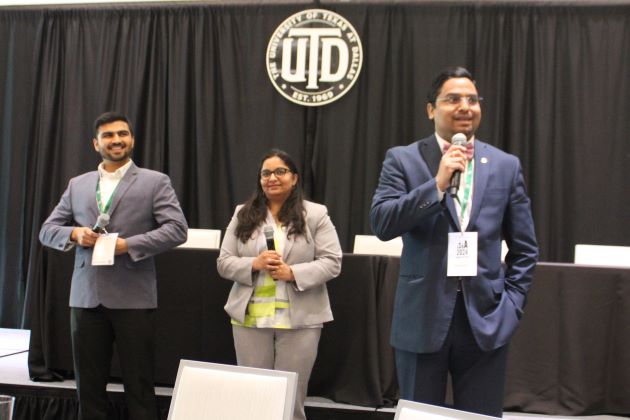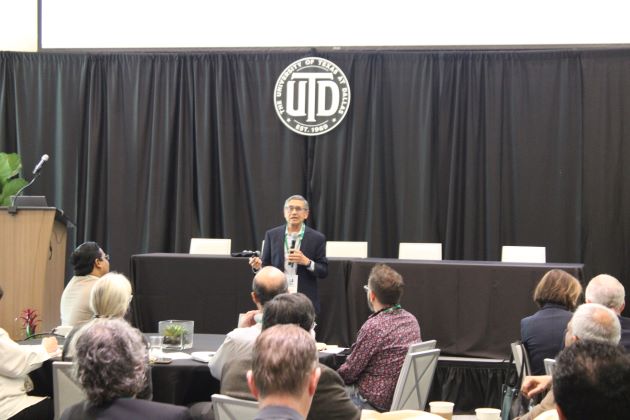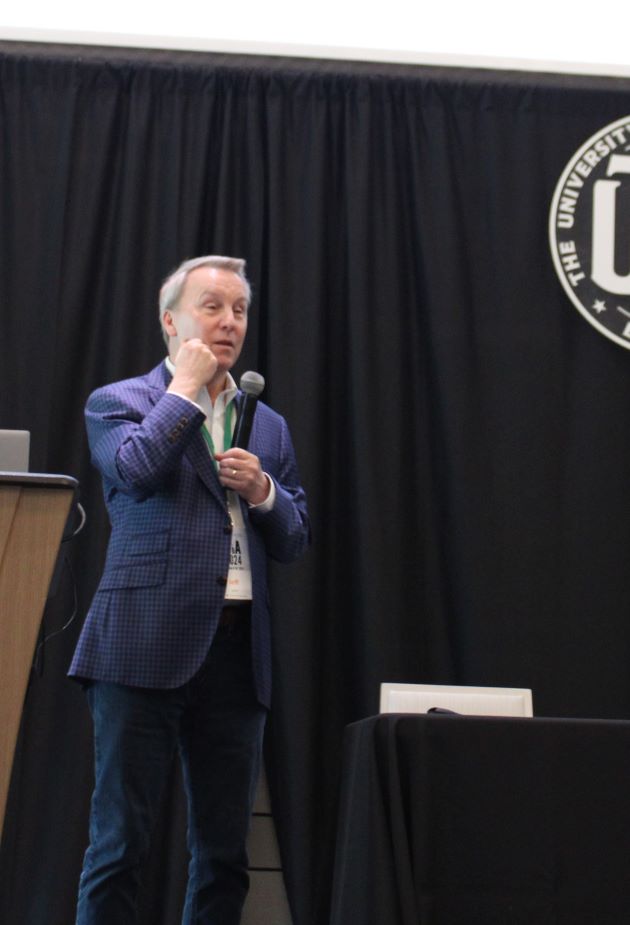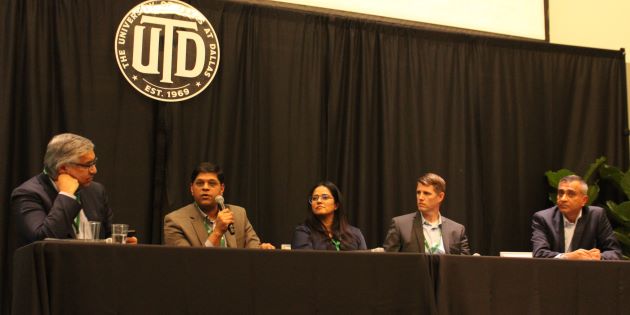Challenges and best practices for business analytics educators preparing students for success in a rapidly changing profession were the focus of the Inaugural Academic Summit for Business Analytics at the Naveen Jindal School of Management Feb. 9-10.

The event was chaired by Gaurav Shekhar, director of the MS Business Analytics program (flex and online) and the senior assistant dean for the Jindal School’s graduate programs. The co-chairs of the event were Dr. Prajakti Akarte, who is the director of the Jindal School’s undergraduate Business Analytics program, and an assistant professor in the Information Systems Area, along with Dr. Vatsal Maru, who is also an assistant professor in the Information Systems Area.
The conference had 95 attendees who represented 45 institutions of higher learning and nine companies. In his welcoming comments to open the summit, Shekhar, an assistant professor in the Information Systems Area, focused on the power of bringing educators together.
Shekhar said that regardless of which trends are being discussed concerning the field of business analytics, they all share related challenges.
“Having a group like this come together shows your willingness to discuss your challenges and share things you are doing that have worked,” he said.
Dr. Hasan Pirkul, Caruth Chair and Jindal School dean, shared information about the school he leads and his background in IS before introducing the keynote speaker.
“We have seen the transition that has taken place in business schools,” he said. “They have become more scientific. Now we are seeing AI [artificial intelligence] and now the practice of business is changing drastically. Everything has to change and these students will be the leaders.”

The keynote speaker was Dr. Ramesh Sharda of Oklahoma State University. He is the Chuck and Kim Watson chair and vice dean for graduate programs and research, Regents professor of management science and information systems, and the ConocoPhillips chair of technology management in the Spears School of Business at OSU.
He also is the author of several books, including “Analytics, Data Science & Artificial Intelligence Systems for Decision;” “Business Intelligence, Analytics, Data Science, and AI;” and “Analytics, Data Science, & Artificial Intelligence: Systems for Decision Support.”
His presentation, “The New Age of Analytics Programs,” addressed future trends, curriculum, and common components of success. He also stressed the importance of a willingness of students to “learn how to learn”—to be willing to continually learn new skills as the analytics landscape evolves.
At OSU, programs have been added, including online and on Saturdays, aimed at preparing students for success in their careers. Changes in the student body also are being addressed.
“There and at other universities a lot of students previously were from India and China, plus other countries,” Sharda said. “Those students will still be interested in coming to our universities in the future, but we all know the winds of political change can affect that. OSU is beginning to wean itself away from international students and work more with domestic students.”
“There will be challenges,” he said, “but every challenge is an opportunity.”

One of those is identifying future trends and creating a curriculum attuned to the changes. Dr. Jeff Camm’s Curriculum Development presentation emphasized those topics. Camm is the senior associate dean of business analytics and the Inmar presidential chair of Analytics at Wake Forest University School of Business. When Camm joined Wake Forest, he created the analytics curriculum. He started with a blank sheet of paper.
“There is so much competition by universities to attract students,” he said. “You have to determine how to leverage your university’s strengths to differentiate your program.”
Today, an important aspect of the curriculum should include teaching communication and interpersonal skills. “Those skills show up in the majority of job ads today because a lack of them is seen as a problem by the industry,” he said.
Camm’s program was followed by a panel discussion of curriculum development moderated by Dr. Patrick Johanns, director of Professional MS in business analytics at the University of Iowa’s Tippie School of Business. Panelists were Dr. William Hefley, director of the MS business analytics cohort program at the Jindal School; Dr. Hemant Jain, director of the MS data analytics program at the University of Tennessee Chattanooga; Dr. Bongsug Chae, professor and John Wefald chair in Business (data analytics initiative) at Kansas State University.
Each panelist provided information on their programs and how their curriculum has evolved. They all agreed they have watched their analytics programs grow.
“We constantly observe the job market and needs of the companies to prepare our students,” said Hefley, who also discussed graduate certificates that students do alongside their degrees. “They help the students on their résumés.”
When Jain started at the University of Tennessee at Chattanooga in 2016, he brought in industry leaders to meet with the deans and they have formed valuable partnerships.
“The kinds of students we get are already experts in their domain but now they need analytics in their domain,” he said. “They want more analytics courses and we are struggling with that.”

A panel discussion — Business Analytics in Practice — was moderated by Dr. Deepak Khazanchi, the Mutual of Omaha Distinguished Chair of Information Science and Technology at the University of Nebraska Omaha. Panelists were Madhavi Vellore, former senior vice president of product management at Mr. Cooper; Dr. Justin Gressel, clinical professor at Southern Methodist University’s Cox School of Business; Dr. Sourav Chatterjee, assistant chair of the Department of Information Technology and Decision Sciences at the University of North Texas; and Mandar Samant, Sr. AVP of Customer Success (Analytics) at EXL and a lecturer in the Management Area at the Jindal School.
Khazanchi began the discussion with a question about the impact of AI on the area of analytics and an AI skills gap.
Panelists agreed that an AI skills gap does exist and, while analytics is not a fad, it will likely change.
“Fad or not, there are so many jobs in analytics but there is an AI skills gap,” Samant said. “I feel that curriculums must somehow move data analytics toward AI.”
While there is a lot of talk about AI now, Vellore said, what will its future be? It is important to learn what companies will need for the next five to 10 years.
Analytics is not a fad according to Chatterjee.
“We need to know who our customers are,” he said. “Sometimes there are small things that we miss and we need analytics.”
The discussion also centered on the importance of somehow being able to predict future trends and update the curriculum to fit employers’ future needs.
“It seems like we always follow business,” Vellore said. “Can universities be ahead of the curve?”
“What is useful could be surveying students for gaps, dealing with the ambiguity, possibly in Capstone projects,” Gressel said.
Dr. Dawn Owens, associate dean of undergraduate programs and a clinical professor in the Information Systems Area at the Jindal School, presented a program on Program Performance and Assessment. Other presentations included student recruitment and retention, leadership and program management, student’s recipe for success, and experiential learning in the AI era.
Sponsors for the event were EXL, GradRight, Alteryx SparkED, Ui Path Academic Alliance, Beta Gamma Sigma, Tableau by Salesforce and Appian.
In addition to Shekhar, other conference organizers from the Jindal School were Dr. Prajakti Akarte, director of the Jindal School’s undergraduate Business Analytics program and an assistant professor in the Information Systems Area; and Dr. Vatsal Maru, an assistant professor in the Information Systems Area.
“We had a very good response,” Shekhar said. “For all of our analytics professors, we have the same programs and challenges. “There is a lot of value in coming together like this and working together and working to keep the light of analytics… alive.”
Akarte added that bringing business analytics leaders together offered a forum for discussing solutions to their challenges, finding answers to important questions, and “sharing ideas for the benefit of our students.”
Maru concluded by stating the inaugural conference is just a beginning.
“Forums like this can only grow from this point onwards,” he said.





